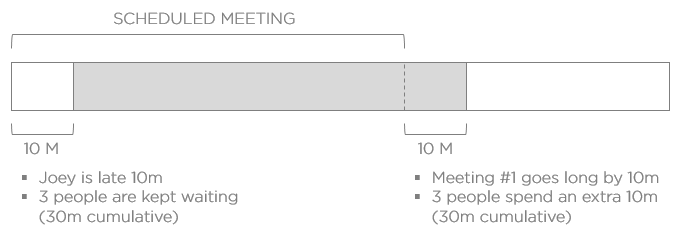Chronic Lateness Syndrome is costing your business
By: Ryan Burgio
April 22, 2016 | Reading Time: 3 mins
Am I the only one whose social feeds are filled with productivity tips, tools and strategies? From the latest time saving tools, to something called a pomodoro timer, everyone’s looking to squeeze as much time as possible out of their day. In digital marketing, there’s a new shiny tool every week that promises to save you hours of time of work while doubling your impact.
But, I’ve got a novel idea; one that will save your team hours upon hours of time per week. You’ll feel like a weight has been lifted off your shoulders. Are you ready for it?
Stop being late for meetings
At Stryve, we believe that the smallest amounts of lateness actually cascade into a major loss of productivity. We use a simple formula to calculate the soul-destroying impact of lateness for calls and meetings. It’s called the Productivity-Crushing Lateness Formula (PCLF).
The Productivity-Crushing Lateness Formula (PCLF)
Total Productivity Crushed = (Minutes Late x 2) x (# of People Impacted) + (3rd Party Impact)
Say, for example, a meeting is scheduled for 10 a.m. Joey, who’s leading the meeting, strolls in at 10:10. We’ve wasted 10 minutes waiting for Joey and now we’ll need an additional 10 minutes to finish the meeting. 10 minutes of lateness actually translates into 20 minutes of lost productivity – this is the doubling effect. You might say, but what if the meeting still wraps up on time? Then it technically should have wrapped up 10 minutes earlier if you weren’t late. Amiright?
Add to this, the number of people in the meeting impacted. Joey has kept Monica, Chandler and Rachel waiting. Our total impact is now 10 x 2 x 3 = 60 minutes. Joey has now wasted a total of 60 minutes because he was 10 minutes late. Who does he think he is?

Because of Joey’s lateness, Chandler has to switch an 11 a.m. meeting with Rachel to 11:10 a.m. We call this the 3rd party impact. Because Rachel was not prepared for this, she has no work planned to be completed at 11 a.m. She’s now probably going to waste an additional 10 minutes of her time. In total, this adds an additional 30 minutes to our calculation for a grand total of 90 minutes. That son of a gun Joey; by showing up 10 minutes late, he has cost the company 90 minutes of productivity.

Now do you wonder why people say they are in meetings all day? Now do you understand why everyone’s working, but nothing’s getting done? It’s because you have a company with chronic lateness syndrome (and Ross, the smart one, was nowhere to be seen).
On-Time All the Time Policy
There’s a simple way to solve this. Instill a policy called On Time All The Time. Here’s how:
- For every meeting an individual shows up late to, instill a small monetary fine of $x to be contributed to a charity or beer account. Keep it lighthearted. People will show up late. Things happen. It’s less about the cost and more about the culture.
- Meetings are to end on time. Anyone can opt-out of the meeting at the completion. If you didn’t allocate enough time to the meeting, that’s your bad. The rest of the team needs to move on with their day.
- Cap your meetings. Meetings should not be longer than an hour. People start to drift and lose interest after an hour.
- Anything over an hour is not a meeting, it’s a working session. These are vital to come up with great strategies and ideas. They require space and time to be free to think, but they aren’t meetings.
This may sound too much like policy, but trust us. When your team becomes accustomed to the life-altering benefits of punctuality, they won’t need to be reminded through penalty. And they will demand accountability and timeliness from others.
Want to see the policy we have in place? Feel free to rip it off.
View the policy
It’s a simple activity that will dramatically change your company culture.
So stop reading this blog and get to that next meeting on time. Your team will thank you for it.








